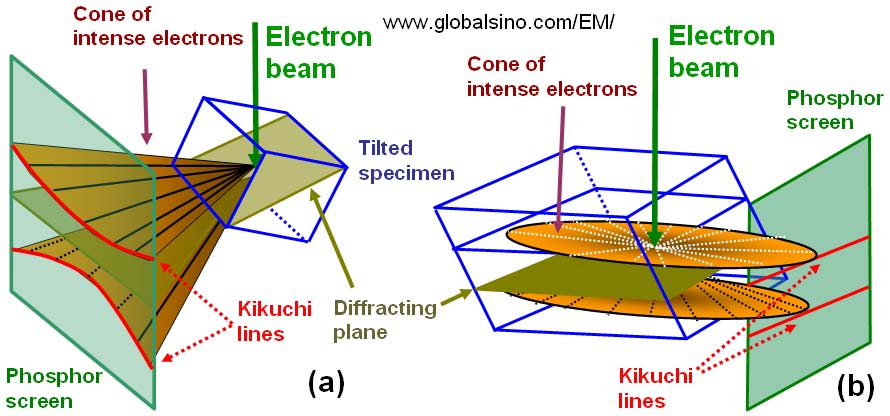=================================================================================
An EBSD pattern consists of a number of Kikuchi bands. Each band comprises a pair of parallel Kikuchi lines. The incident electron beam is directed to the point of interest (POI) on the sample surface and thus, the elastic scattering of the electron beam induces the electrons to diverge from a point just below the sample surface and to impinge on crystal planes in all directions. Backscattered electrons that satisfy Bragg's law for a given plane generate two diffraction cones from the front and back surfaces of the plane. These cones are produced for each family of lattice planes. When these cones intersect the phosphor screen or camera thin bands are formed. These bands are called Kikuchi lines. The Kikuchi lines appear as almost straight lines because the cones are very shallow due to the small Bragg angle (order 1°) with a very small electron wavelength. EBSD software can automatically analyze the individual Kikuchi lines by comparing them with the theoretical Kikuchi lines in database.
For better understanding, Figure 2334 (a) and (b) shows the formation of Kikuchi lines and electron backscatter diffraction pattern in different ways.

Figure 2334 (a) and (b). The formation of Kikuchi lines and electron backscatter diffraction pattern in different ways.
Traditional EBSD methods use Hough transforms to determine the position of Kikuchi bands on the phosphor screen. [1 - 2] The Hough transform provides a proper technique for obtaining the parameters of a straight line and thus the positions of Kikuchi bands in an EBSP (electron backscatter diffraction pattern). Lines in the pattern are converted to spots in Hough Space.
[1] Krieger Lassen, N.C., Conradsen, K. & Juul Jensen, D. (1992). Image-processing procedures for analysis of electron back scattering patterns. Scanning Microsc 6(1), 115–121.
[2] Adams, B.L.,Wright, S.I. & Kunze, K. (1993). Orientation imaging: The emergence of a new microscopy. Metall Trans A 24A(4), 819–831.
|
